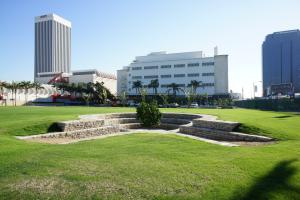The grass has grown in around a notable project at the northwest corner of campus, near Fairfax Avenue: The Public Fruit Theater, Los Angeles, 2010, designed and built by La Loma Development. La Loma collaborated with artist collective Fallen Fruit to build the theater as part of our year-long investigation EATLACMA, which concluded this past November. The Public Fruit Theater remains, as what landscape architect Marco Barrantes calls “a monument to the fruit tree.”

Photo courtesy of La Loma Development
The fruit tree is surrounded by a garden wall composed of broken concrete from the sidewalks and driveways that paved over Southern California orchards beginning around 100 years ago. Marco and his partner, Michelle Matthews, often design with broken concrete. “Recycled concrete is perhaps the most local, sustainable, renewable resource at our disposal,” says Marco. “Often it goes into landfill or piles up at recycling facilities.” Instead, La Loma used different forms of recycled concrete for the retaining wall, the base, and for the drainage gravel.
They used a technique, called drystack terracing, to build the garden wall without mortar—a technique that dates back thousands of years. “Drystack terraces were used throughout the Andes, including at at Machu Pichu,” says Marco, who is from Peru, but grew up in Southern California. “Drystacking results in a malleable, adaptable wall. Instead of cracking or settling, it will just adjust to the landscape. If you’re going to do landscaping in the hills, or even in flat areas, like LACMA, it’s a great landscape material—there’s nothing better.” The garden is zero maintenance, due to terraforming and the use of gravel base and backing to prevent water-logged soil and roots from pressing up against the garden wall. “You should be able to enjoy a garden without having to mow or use a leaf blower,” says Marco.
Michelle says the duo takes inspiration from permaculture and land art. “There are connections between land art, or earth works, the landscape and our gardens at home," says Michelle. “If done right, there can be beauty in retaining walls. Landscape art can be an integral and aesthetic part of the urban fabric."
This time-lapse video shows the project coming together over the course of ten days. Each piece of broken concrete is hand-picked and chiseled and fit together like a puzzle. John Bowsher, director of special installations at LACMA, helped Marco and Michelle navigate that process in order to realize their vision. “Because people can sit on it, climb on it, and because we called it an amphitheater, the project was subject to some special requirements,” Marco explains.
“While we typically prefer to remove lawns in Southern California, we were delighted to see the monument enveloped by a field of green” says Michelle. “There is a busy bus stop nearby, but the fruit theater is this quiet, meditative place. I hope the public will use it and see it as a place of relaxation and an opportunity to reflect upon our local landscape and how we can make our city more enjoyable, healthy and beautiful through sustainable means.”
Amy Heibel



